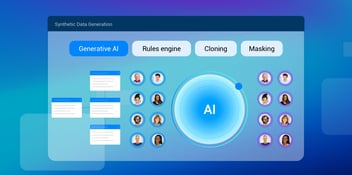Synthetic patient data is artificially created medical data used for research and treatment improvement efforts that doesn’t infringe on patient privacy.
Table of Contents
What is Synthetic Patient Data?
Why Healthcare Researchers Need Synthetic Patient Data
Synthetic Patient Data Creation
Synthetic Patient Data Use Cases
Synthetic Patient Data Challenges
Entity-Based Synthetic Patient Data Generation
What is Synthetic Patient Data?
Synthetic patient data is data that has been artificially created yet still closely resembles actual medical data. The key difference is that synthetic patient data contains no Personally Identifiable Information (PII). Synthetic patient data mimics the actual structure, format and other mathematical or statistical characteristics of real-life patient data. It can be an excellent solution for researchers looking to simulate realistic scenarios and develop and validate medical algorithms and methodologies, even when actual patient data is unavailable owing to privacy concerns.
Why Healthcare Researchers Need Synthetic Patient Data
By using synthetic patient data, healthcare researchers improve:
-
Patient privacy
The use of real patient data may violate data privacy laws. Medical researchers can overcome these limitations by using synthetic patient data to conduct their studies without compromising patient privacy. -
Data balance
While real patient data can exhibit imbalances that affect the accuracy of models, demographics, and medical conditions, synthetic patient data lets researchers create balanced datasets by training their algorithms on more representative samples. -
Testing control
Synthetic patient data lets researchers create diverse yet controlled datasets that emulate many different medical scenarios or conditions. This enables more thorough testing and validation of algorithms, models, and methodologies. -
Treatment efficacy
Synthetic patient data lets researchers test the efficacy of new treatments in a simulated environment before they move on to clinical trials. By refining iterative testing, synthetic patient data accelerates the development of new medical techniques, technologies, and treatments.
Synthetic Patient Data Creation
Synthetic patient data is created by advanced algorithms that generate artificial data points by mimicking real patient information. To ensure compliance with privacy regulations and align with ethical considerations, synthetic patient data is usually created using various data anonymization and data de-identification techniques.
Here are 4 key methodologies for creating synthetic patient data:
-
Generative models, like variational autoencoders (VAEs) or generative adversarial networks (GANs), are trained on actual patient data to learn underlying patterns. They then generate synthetic samples that approximate original patient data by capturing the statistical structure of the data and closely matching it to the distribution of the actual data.
-
Data augmentation modifies real patient data by introducing variations. For example, techniques like random noise addition, perturbation, and oversampling are applied to enrich the dataset and increase its diversity.
-
Rule-based generation uses rules and algorithms to create synthetic data according to the patterns and characteristics of actual patient data. The rules might include medical guidelines, statistical distributions, and best practices to ensure the synthetic patient data closely reflects real-world scenarios.
-
Hybrid approaches, such as the combination of generative models with rule-based generation, can create high-level patterns aligned with specific criteria.
Synthetic Patient Data Use Cases
The versatility of synthetic patient data makes it a potentially valuable resource for furthering medical research and improving patient care, while effectively addressing privacy concerns. How is synthetic patient data used?
First, synthetic patient data can be a valuable resource for training healthcare researchers, professionals, and medical students. When used in simulation-based training programs. synthetic patient data helps create realistic patient cases and scenarios – allowing trainees to practice their clinical decision-making in a controlled environment.
Second, synthetic patient data can be used to develop and validate healthcare algorithms – including diagnostic algorithms, treatment recommendation systems, and predictive models. Researchers use this realistic, yet synthetic, patient data to simulate multiple patient scenarios, evaluating the performance and accuracy of their algorithms. This kind of in-depth validation enables simpler and more effective exploration of new hypotheses, testing of novel interventions, and investigation of rare medical events.
Third, synthetic patient data helps researchers evaluate different methodologies, algorithms, and healthcare decision-making software for comparative analysis against established benchmarks.
Finally, synthetic patient data enables easier and smoother data collaboration by eliminating privacy concerns. Rather than sharing real patient data, medical professionals can use synthetic patient data for cross-industry or cross-institutional collaborations, data-driven studies, and algorithm evaluations – all while maintaining full compliance with data protection regulations.
Synthetic Patient Data Challenges
Despite its many benefits, synthetic patient data still has its challenges, including:
-
Data quality and referential integrity
Not only does synthetic patient data have to be realistic to be useful, it must also retain its integrity (characteristics, format, and structure) across all target systems. -
Representation
Synthetic patient data needs to accurately represent the highly variable characteristics, demographics, and medical conditions of actual patient populations. It’s difficult to ensure that the synthetic data covers a sufficiently wide range of scenarios to accurately capture the complexity of actual patient data. -
Validation
Validating the reliability of synthetic patient data is challenging because it demands comparison of algorithms or methodologies that use synthetic data against those using real patient data – which may not be accessible. -
Privacy
Synthetic patient data undoubtedly addresses privacy concerns. Yet there remains a risk of re-identification or leakage of sensitive information. -
Data imbalance
Synthetic patient data generation does not always successfully reflect rare medical conditions, events, or outlier cases – all of which are crucial for research and algorithm development.
Entity-Based Synthetic Patient Data Generation
Medical researchers are turning to entity-based synthetic data generation solutions because they can generate fake data whose referential integrity is strictly enforced. All the relevant data for a particular patient is always generated and contextually precise.
Entity-based synthetic data generation uses a variety of data generation techniques (alone or in tandem) to create synthetic patient data, including:
-
Generative AI, which depends on machine learning to create realistic and rich tabular data
-
A rules engine, which generates patient data based on any number of rules and statistical distributions applied to the model
-
Data cloning, which duplicates a single entity (with all its related data), but changes the identifiers in each clone
-
Data masking, which obfuscates real patient information, at the patient entity level, causing the source entities to become realistic-looking synthetic data
Only 1 synthetic data generation tool supports all 4 techniques.















